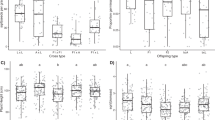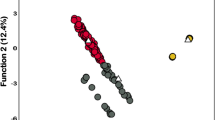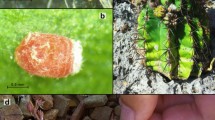Abstract
Hybridization between invasive pest species may lead to significant genetic and economic impacts that require close monitoring. The two most invasive and destructive termite species worldwide, Coptotermes formosanus Shiraki and Coptotermes gestroi (Wasmann), have the potential for hybridization in the field. A three-year field survey conducted during the dispersal flight season of Coptotermes in Taiwan identified alates with atypical morphology, which were confirmed as hybrids of the two Coptotermes species using microsatellite and mitochondrial analyses. Out of 27,601 alates collected over three years, 4.4% were confirmed as hybrid alates, and some advanced hybrids (>F1 generations) were identified. The hybrid alates had a dispersal flight season that overlapped with the two parental species 13 out of 15 times. Most of the hybrid alates were females, implying that mating opportunities beyond F1 may primarily be possible through female hybrids. However, the incipient colony growth results from all potential mating combinations suggest that only backcross colonies with hybrid males could sometimes lead to brood development. The observed asymmetrical viability and fertility of hybrid alates may critically reduce the probability of advanced-hybrid colonies being established in the field.
This is a preview of subscription content, access via your institution
Access options
Subscribe to this journal
Receive 12 print issues and online access
$259.00 per year
only $21.58 per issue
Buy this article
- Purchase on Springer Link
- Instant access to full article PDF
Prices may be subject to local taxes which are calculated during checkout





Similar content being viewed by others
Data availability
Supplementary figures, tables, and text can be downloaded from the online article version. Input files for population genetic analyses can be found on Dryad (https://doi.org/10.5061/dryad.n2z34tn4g).
References
Anderson CJ, Oakeshott JG, Tay WT, Gordon KH, Zwick A, Walsh TK (2018) Hybridization and gene flow in the mega-pest lineage of moth, Helicoverpa. Proc Natl Acad Sci USA 115(19):5034–5039. https://doi.org/10.1073/pnas.1718831115.
Anderson E, Thompson E (2002) A model-based method for identifying species hybrids using multilocus genetic data. Genetics 160(3):1217–1229. https://doi.org/10.1093/genetics/160.3.1217.
Andrade T (2008) How Taiwan became Chinese: Dutch, Spanish, and Han colonization in the seventeenth century. Columbia University Press, New York.
Arnold ML, Bulger MR, Burke JM, Hempel AL, Williams JH (1999) Natural hybridization: how low can you go and still be important? Ecology 80(2):371–381. https://doi.org/10.2307/176618.
Barbanera F, Pergams OR, Guerrini M, Forcina G, Panayides P, Dini F (2010) Genetic consequences of intensive management in game birds. Biol conserv 143(5):1259–1268. https://doi.org/10.1016/j.biocon.2010.02.035.
Bevins SN, Pedersen K, Lutman MW, Gidlewski T, Deliberto TJ (2014) Consequences associated with the recent range expansion of nonnative feral swine. BioScience 64(4):291–299. https://doi.org/10.1093/biosci/biu015
Bignell DE, Roisin Y, Lo N (2010) Biology of termites: a modern synthesis. Springer, Dordrecht, The Netherlands.
Bordereau C, Pasteels JM (2010). Pheromones and chemical ecology of dispersal and foraging in termites. In: Bignell DE, Roisin Y, Lo N (eds) Biology of termites: a modern synthesis. Springer, Dordrecht, The Netherlands, pp 279-320.
Bourguignon T, Lo N, Šobotník J, Sillam-Dussès D, Roisin Y, Evans TA (2016) Oceanic dispersal, vicariance and human introduction shaped the modern distribution of the termites Reticulitermes, Heterotermes and Coptotermes. Proc Royal Soc B 283(1827): 20160179. https://doi.org/10.1098/rspb.2016.0179
Calfee E, Agra MN, Palacio MA, Ramirez SR, Coop G (2020) Selection and hybridization shaped the rapid spread of African honey bee ancestry in the Americas. PLoS Genet 16(10):e1009038. https://doi.org/10.1371/journal.pgen.1009038.
Cao R, Su N-Y (2016) Temperature preferences of four subterranean termite species (Isoptera: Rhinotermitidae) and temperature-dependent survivorship and wood-consumption rate. Ann Entomol Soc Am 109(1):64–71. https://doi.org/10.1093/aesa/sav095.
Chouvenc T (2019) The relative importance of queen and king initial weights in termite colony foundation success. Insectes Soc 66(2):177–184. https://doi.org/10.1007/s00040-019-00690-3.
Chouvenc T (2022). Eusociality and the transition from biparental to alloparental care in termites. Funct Ecol. https://doi.org/10.1111/1365-2435.14183.
Chouvenc T, Helmick EE, Su N-Y (2015) Hybridization of two major termite invaders as a consequence of human activity. PLoS One 10(3):e0120745. https://doi.org/10.1371/journal.pone.0120745.
Chouvenc T, Osorio S, Chakrabarti S, Helmick EE, Li H-F, Su N-Y (2017a) Assessment of genetic markers for the determination of Coptotermes formosanus× Coptotermes gestroi (Isoptera: Rhinotermitidae) F1 hybrids. Fla Entomol 100(3):657–659. https://doi.org/10.1653/024.100.0325.
Chouvenc T, Scheffrahn RH, Mullins AJ, Su N-Y (2017b) Flight phenology of two Coptotermes species (Isoptera: Rhinotermitidae) in southeastern Florida. J Econ Entomol 110(4):1693–1704. https://doi.org/10.1093/jee/tox136.
Chouvenc T, Sillam-Dussès D, Robert A (2020) Courtship behavior confusion in two subterranean termite species that evolved in allopatry (Blattodea, Rhinotermitidae, Coptotermes). J Chem Ecol 46(5):461–474. https://doi.org/10.1007/s10886-020-01178-2.
Chunco AJ (2014) Hybridization in a warmer world. Ecol Evol 4(10):2019–2031. https://doi.org/10.1002/ece3.1052.
Cohen P, Privman E (2019) Speciation and hybridization in invasive fire ants. BMC Evol Biol 19(1):111. https://doi.org/10.1186/s12862-019-1437-9.
Costa-Leonardo AM, Janei V, da Silva IB (2022). Comparative reproductive biology of pre-, imaginal, and neotenic castes of the Asian termite Coptotermes gestroi (Blattaria, Isoptera, Rhinotermitidae). Bull Entom Res, 1–10. https://doi.org/10.1017/S0007485322000232.
Crispo E, Moore JS, Lee-Yaw JA, Gray SM, Haller BC (2011) Broken barriers: Human-induced changes to gene flow and introgression in animals. Bioessays 33(7):508–518. https://doi.org/10.1002/bies.201000154.
Dejager L, Libert C, Montagutelli X (2009) Thirty years of Mus spretus: a promising future. Trends Genet 25(5):234–241. https://doi.org/10.1016/j.tig.2009.03.007.
Earl DA, VonHoldt BM (2012) STRUCTURE HARVESTER: a website and program for visualizing STRUCTURE output and implementing the Evanno method. Conserv Genet Resour 4(2):359–361. https://doi.org/10.1007/s12686-011-9548-7.
Ellstrand NC, Schierenbeck KA (2000) Hybridization as a stimulus for the evolution of invasiveness in plants? Proc Natl Acad Sci USA 97(13):7043–7050. https://doi.org/10.1073/pnas.97.13.7043
Evans TA, Forschler BT, Grace JK (2013) Biology of invasive termites: a worldwide review. Annu Rev Entomol 58: 455-474. https://doi.org/10.1146/annurev-ento-120811-153554
Evanno G, Regnaut S, Goudet J (2005) Detecting the number of clusters of individuals using the software STRUCTURE: a simulation study. Mol Ecol 14(8):2611–2620. https://doi.org/10.1111/j.1365-294X.2005.02553.x.
Fitzpatrick BM, Shaffer HB (2007) Hybrid vigor between native and introduced salamanders raises new challenges for conservation. Proc Natl Acad Sci USA 104(40):15793–15798. https://doi.org/10.1073/pnas.0704791104.
Fournier D, Aron S (2021) Hybridization and invasiveness in social insects—The good, the bad and the hybrid. Curr Opin Insect Sci 46:1–9. https://doi.org/10.1016/j.cois.2020.12.004.
Frankham R, Ballou JD, Eldridge MDB, Lacy RC, Ralls K, Dudash MR et al. (2011) Predicting the probability of outbreeding depression. Conserv Biol 25(3):465–475. https://doi.org/10.1111/j.1523-1739.2011.01662.x.
Gay FJ (1969) Species introduced by man. In: Krishna K and Weesner FM (eds) Biology of Termites, vol. 1. Academic, New York, pp 459–494.
Goedbloed D, Megens H, Van Hooft P, Herrero-Medrano J, Lutz W, Alexandri P et al (2013) Genome-wide single nucleotide polymorphism analysis reveals recent genetic introgression from domestic pigs into Northwest European wild boar populations. Mol Ecol 22(3):856–866. https://doi.org/10.1111/j.1365-294X.2012.05670.x
Hammer Ø, Harper DA, Ryan PD (2001) PAST: Paleontological statistics software package for education and data analysis. Palaeontol Electron 4(1):9.
Hapukotuwa NK, Grace JK (2011) Preferences of Coptotermes formosanus Shiraki and Coptotermes gestroi (Wasmann)(Blattodea: Rhinotermitidae) among three commercial wood species. Insects 2(4):499–508. https://doi.org/10.3390/insects2040499.
Hapukotuwa NK, Grace JK (2012) Coptotermes formosanus and Coptotermes gestroi (Blattodea: Rhinotermitidae) exhibit quantitatively different tunneling patterns. Psyche, https://doi.org/10.1155/2012/675356.
Hartke TR, Baer B (2011) The mating biology of termites: a comparative review. Anim Behav 82(5):927–936. https://doi.org/10.1016/j.anbehav.2011.07.022.
Huang S-Y (2020). Survey of household termite species composition and swarming season. Master thesis, National Chung Hsing University, Taichung.
Huang S-Y, Chiu C-I, Tsai Y-Y, Li W-J, Wu C-C, Li H-F (2022). Nationwide Termite Pest Survey Conducted in Taiwan as a Citizen Science Project. J Econ Entomol, https://doi.org/10.1093/jee/toac122.
Kanbe Y, Okada I, Yoneda M, Goka K, Tsuchida K (2008) Interspecific mating of the introduced bumblebee Bombus terrestris and the native Japanese bumblebee Bombus hypocrita sapporoensis results in inviable hybrids. Naturwissenschaften 95(10):1003–1008. https://doi.org/10.1007/s00114-008-0415-7.
Kistner D (1985) A new genus and species of termiphilous aleocharinae from mainland China associated with Coptotermes formosanus and its zoogeographic significance (Coleoptera: Staphylinidae). Sociobiology 10(1):93–104.
Laster M, Sheng C (1995) Search for hybrid sterility for Helicoverpa zea in crosses between the North American H. zea and H. armigera (Lepidoptera: Noctuidae) from China. J Econ Entomol 88(5):1288–1291. https://doi.org/10.1093/jee/88.5.1288.
Lee S-B, Chouvenc T, Patel J, Su N-Y (2020) Altered mobility and accumulation of inefficient workers in juvenile hybrid termite colonies. Front Ecol Evol 8:448. https://doi.org/10.3389/fevo.2020.589762.
Lefebvre T, Chaline N, Limousin D, Dupont S, Bagneres AG (2008) From speciation to introgressive hybridization: the phylogeographic structure of an island subspecies of termite, Reticulitermes lucifugus corsicus. BMC Evol Biol 8:38. https://doi.org/10.1186/1471-2148-8-38.
Li H-F (2010) Morphology of important termite pests on genus and species levels. In: Wu W-J, Shih H-T (eds) Introduction to morphology and ecology of immature stages of the important agricultural insects on family, subfamily, and species levels. National Taiwan University, Taipei, Taiwan, pp 21-44.
Li H-F, Su N-Y, Wu W-J (2010) Solving the hundred-year controversy of Coptotermes taxonomy in Taiwan. Am Entomol 56:222–227. https://doi.org/10.1093/ae/56.4.222.
Li H-F, Ye W-M, Su N-Y, Kanzaki N (2009) Phylogeography of Coptotermes gestroi and Coptotermes formosanus (Isoptera: Rhinotermitidae) in Taiwan. Ann Entomol Soc Am 102(4):684–693. https://doi.org/10.1603/008.102.0413.
Liang W-R, Maruyama M, Kanao T, Iwata R, Li H-F (2020) Discovery of termitophilous rove beetles associated with Formosan subterranean termite Coptotermes formosanus in Taiwan, with the first larval description for the tribe Termitohospitini (Coleoptera: Staphylinidae). Acta Entomol Mus Natl Prag 60(1):77–87. https://doi.org/10.37520/aemnp.2020.005.
Liou LW, Price TD (1994) Speciation by reinforcement of premating isolation. Evolution 48(5):1451–1459. https://doi.org/10.1111/j.1558-5646.1994.tb02187.x.
Maan ME, Seehausen O, Van Alphen JJ (2010) Female mating preferences and male coloration covary with water transparency in a Lake Victoria cichlid fish. Biol J Linn Soc 99(2):398–406. https://doi.org/10.1111/j.1095-8312.2009.01368.x.
Mallet J (2007) Hybrid speciation. Nature 446(7133):279–283. https://doi.org/10.1038/nature05706.
Maruyama M, Iwata R (2002) Two new termitophiles of the tribe Termitohospitini (Coleoptera: Staphylinidae: Aleocharinae) associated with Coptotermes formosanus (Isoptera: Rhinotermitidae). Can Entomol 134(4):419–432. https://doi.org/10.4039/Ent134419-4.
Mattucci F, Galaverni M, Lyons LA, Alves PC, Randi E, Velli E et al. (2019) Genomic approaches to identify hybrids and estimate admixture times in European wildcat populations. Sci Rep 9(1):11612. https://doi.org/10.1038/s41598-019-48002-w.
Meeker ND, Hutchinson SA, Ho L, Trede NS (2007) Method for isolation of PCR-ready genomic DNA from zebrafish tissues. Biotechniques 43(5):610–614. https://doi.org/10.2144/000112619.
Mizumoto N, Rizo A, Pratt SC, Chouvenc T (2020) Termite males enhance mating encounters by changing speed according to density. J Anim Ecol 89(11):2542–2552. https://doi.org/10.1111/1365-2656.13320.
Moran BM, Payne C, Langdon Q, Powell DL, Brandvain Y, Schumer M (2021) The genomic consequences of hybridization. Elife 10:e69016. https://doi.org/10.7554/elife.69016.
Nalepa CA, Jones SC (1991) Evolution of monogamy in termites. Biol Rev 66(1):83–97. https://doi.org/10.1111/j.1469-185X.1991.tb01136.x.
Nozaki T, Matsuura K (2021) Oocyte resorption in termite queens: Seasonal dynamics and controlling factors. J Insect Physiol 131:104242. https://doi.org/10.1016/j.jinsphys.2021.104242.
Nutting WL (1969) Flight and colony foundation. In: Krishna K and Weesner FM (eds) Biology of termites. Academic Press, New York, pp. 233–282.
Ohadi S, Ades PK, Ford R, Strand AE, Tibbits J, Mesgaran MB et al. (2016) Genetic structure along the strandline: Unravelling invasion history in a one‐dimensional system. J Biogeogr 43(3):451–460. https://doi.org/10.1111/jbi.12640.
Orth A, Belkhir K, Britton-Davidian J, Boursot P, Benazzou T, Bonhomme F (2002) Natural Hybridisation between two sympatric species of mice Mus musculus domesticus L. and Mus spretus Lataste. Comptes Rendus Biologies 325(2):89–97. https://doi.org/10.1016/s1631-0691(02)01413-0.
Oster GF, Wilson EO (1978) Caste and ecology in the social insects. Princeton University Press, Princeton, NJ.
Patel JS, Tong RL, Chouvenc T, Su NY (2019) Comparison of temperature-dependent survivorship and wood-consumption rate among two invasive subterranean termite species (Blattodea: Rhinotermitidae: Coptotermes) and their hybrids. J Econ Entomol 112(1):300–304. https://doi.org/10.1093/jee/toy347.
Patel JS, Chouvenc T, Su NY (2019a) Temperature preference of two invasive subterranean termite species and their hybrids (Blattodea: Rhinotermitidae: Coptotermes). J Econ Entomol 112(6): 2888-2893. https://doi.org/10.1093/jee/toz210
Patel JS, Tong RL, Chouvenc T, Su NY (2019b) Comparison of temperature-dependent survivorship and wood-consumption rate among two invasive subterranean termite species (Blattodea: Rhinotermitidae: Coptotermes) and their hybrids. J Econ Entomol 112(1): 300-304. https://doi.org/10.1093/jee/toy347
Peakall R, Smouse PE (2006) GENALEX 6: genetic analysis in Excel. Population genetic software for teaching and research. Mol Ecol Notes 6(1):288–295. https://doi.org/10.1111/j.1471-8286.2005.01155.x.
Price M, Waser N (1979) Pollen dispersal and optimal outcrossing in Delphinium nelsoni. Nature 277(5694):294–297. https://doi.org/10.1038/277294a0.
Pritchard JK, Stephens M, Donnelly P (2000) Inference of population structure using multilocus genotype data. Genetics 155(2):945–959. https://doi.org/10.1093/genetics/155.2.945.
Rieseberg LH, Kim S-C, Randell RA, Whitney KD, Gross BL, Lexer C et al (2007) Hybridization and the colonization of novel habitats by annual sunflowers. Genetica 129(2): 149-165. https://doi.org/10.1007/s10709-006-9011-y
Rieseberg LH, Raymond O, Rosenthal DM, Lai Z, Livingstone K, Nakazato T et al. (2003) Major ecological transitions in wild sunflowers facilitated by hybridization. Science 301(5637):1211–1216. https://doi.org/10.1126/science.1086949.
Rubidge E, Corbett P, Taylor EB (2001) A molecular analysis of hybridization between native westslope cutthroat trout and introduced rainbow trout in southeastern British Columbia, Canada. J Fish Biol 59:42–54. https://doi.org/10.1111/j.1095-8649.2001.tb01377.x.
Rust MK, Su NY (2012) Managing social insects of urban importance. Annu Rev Entomol 57: 355-375. https://doi.org/10.1146/annurev-ento-120710-100634
Satokangas I, Nouhaud P, Seifert B, Punttila P, Schultz R, Jones M et al. (2023) Semipermeable species boundaries create opportunities for gene flow and adaptive potential. Mol Ecol, https://doi.org/10.1111/mec.16992
Scheffrahn RH, Su N-Y (2005) Distribution of the termite genus Coptotermes (Isoptera: Rhinotermitidae) in Florida. Fla Entomol 88(2): 201-203. https://doi.org/10.1653/0015-4040(2005)088[0201:DOTTGC]2.0.CO;2
Scheffrahn RH, Su N-Y (2000) Asian subterranean termite, Coptotermes gestroi (= havilandi)(Wasmann)(Insecta: Isoptera: Rhinotermitidae). Extension document EENY-128 Institute of Food and Agricultural Sciences. University of Florida, Gainesville, FL
Schumacher MJ, Egen NB (1995) Significance of Africanized bees for public health: a review. Arch Intern Med 155(19):2038–2043.
Scott Schneider S, DeGrandi-Hoffman G, Smith DR (2004) The African honey bee: factors contributing to a successful biological invasion. Annu Rev Entomol 49(1):351–376. https://doi.org/10.1146/annurev.ento.49.061802.123359.
Servedio MR, Noor MA (2003) The role of reinforcement in speciation: theory and data. Annu Rev Ecol Evol Syst 34(1):339–364. https://doi.org/10.1146/annurev.ecolsys.34.011802.132412.
Slatkin M (1985) Rare alleles as indicators of gene flow. Evolution 39(1):53–65. https://doi.org/10.2307/2408516.
Smouse PE, Peakall R (2012) GenAlEx 6.5: genetic analysis in Excel. Population genetic software for teaching and research—an update. Bioinformatics 28(19):2537–2539. https://doi.org/10.1093/bioinformatics/bts460.
Song Y, Endepols S, Klemann N, Richter D, Matuschka FR, Shih CH et al. (2011) Adaptive introgression of anticoagulant rodent poison resistance by hybridization between old world mice. Curr Biol 21(15):1296–1301. https://doi.org/10.1016/j.cub.2011.06.043.
Stebbins GL (1959) The role of hybridization in evolution. Proc Am Philos Soc 103(2):231–251.
Su N-Y (2002) Novel technologies for subterranean termite control. Sociobiology 40(1):95–102.
Su N-Y, Scheffrahn RH, Weissling T (1997) A new introduction of a subterranean termite, Coptotermes havilandi Holmgren (Isoptera: Rhinotermitidae) in Miami, Florida. Fla Entomol: 408-408. https://doi.org/10.2307/3495774
Su N-Y, Chouvenc T, Li H-F (2017) Potential hybridization between two invasive termite species, Coptotermes formosanus and C. gestroi (Isoptera: Rhinotermitidae), and its biological and economic implications. Insects 8(1): 14. https://doi.org/10.3390/insects8010014
Su X-H, Wei Y-H, Liu M-H (2014) Ovarian development and modes of apoptosis during oogenesis in various castes of the termite Reticulitermes aculabialis. Physiol Entomol 39(1):44–52. https://doi.org/10.1111/phen.12046.
Tay WT, Soria MF, Walsh T, Thomazoni D, Silvie P, Behere GT et al. (2013) A brave new world for an old world pest: Helicoverpa armigera (Lepidoptera: Noctuidae) in Brazil. PLoS One 8(11):e80134. https://doi.org/10.1371/journal.pone.0080134.
Taylor E, Boughman J, Groenenboom M, Sniatynski M, Schluter D, Gow J (2006) Speciation in reverse: morphological and genetic evidence of the collapse of a three‐spined stickleback (Gasterosteus aculeatus) species pair. Mol Ecol 15(2):343–355. https://doi.org/10.1111/j.1365-294X.2005.02794.x.
VÄHÄ JP, Primmer CR (2006) Efficiency of model‐based Bayesian methods for detecting hybrid individuals under different hybridization scenarios and with different numbers of loci. Mol Ecol 15(1):63–72. https://doi.org/10.1111/j.1365-294X.2005.02773.x.
Valencia-Montoya WA, Elfekih S, North HL, Meier JI, Warren IA, Tay WT et al. (2020) Adaptive introgression across semipermeable species boundaries between local Helicoverpa zea and invasive Helicoverpa armigera moths. Mol Biol Evol 37(9):2568–2583. https://doi.org/10.1101/2019.12.15.877225.
Wright S (1931) Evolution in Mendelian populations. Genetics 16(2):97. https://doi.org/10.1016/S0092-8240(05)80011-4.
Woodrow R, Gracez J, Higa S (2001). Occurrence of Coptotermes vastator (lsoptera: Flhinotermitidae) on the island of Oahu, Hawaii. Sociobiology 38(3B).
Acknowledgements
We thank Chun-I Chiu for giving advice on data analysis; Wen-Jun Lin, Ren-Hen Liu, Chia-Chien Wu, Mu-Xuan Chen, Hsiang-Chun Liu, and Yi-Ning Chiu (NCHU) for assisting the field works. We thank every citizen scientist who provided termite samples. This study was supported by the Ministry of Science and Technology, Taiwan (MOST 105-2628-B-005-003-MY3, MOST 108-2628-B-005-004, and MOST 109-2628-B-005-007). The authors acknowledge the Genomics Center for Clinical and Biotechnological Applications of National Core Facility for Biopharmaceuticals, Taiwan (NSTC 111-2740-B-A49-001) for sequencing.
Author information
Authors and Affiliations
Contributions
GYC, SYH, YHC and HFL designed the study. GYC and SYH collected the data. GYC, YHC, MDL and HFL interpreted the results. GYC analyzed the data and wrote the manuscript. YHC, MDL, TC and HFL revised the manuscript. HFL acquired funding for the project. All authors read and approved the manuscript.
Corresponding authors
Ethics declarations
Competing interests
The authors declare no competing interests.
Ethics
The research involved insects only and was exempt from ethical approval.
Additional information
Publisher’s note Springer Nature remains neutral with regard to jurisdictional claims in published maps and institutional affiliations.
Associate editor: Lounès Chikhi.
Supplementary information
Rights and permissions
Springer Nature or its licensor (e.g. a society or other partner) holds exclusive rights to this article under a publishing agreement with the author(s) or other rightsholder(s); author self-archiving of the accepted manuscript version of this article is solely governed by the terms of such publishing agreement and applicable law.
About this article
Cite this article
Chen, GY., Huang, SY., Lin, MD. et al. Hybrids of two destructive subterranean termites established in the field, revealing a potential for gene flow between species. Heredity (2024). https://doi.org/10.1038/s41437-024-00679-0
Received:
Revised:
Accepted:
Published:
DOI: https://doi.org/10.1038/s41437-024-00679-0



